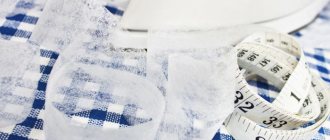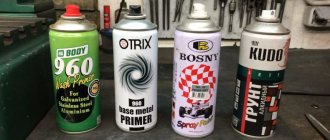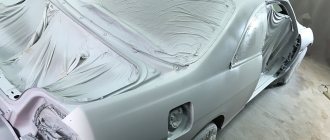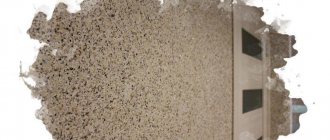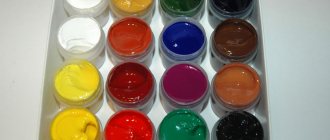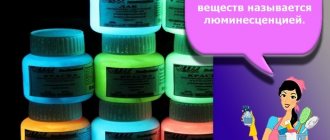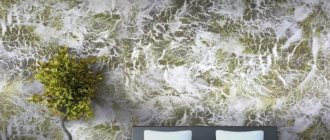Most modern cars have two- or three-layer coatings, in which the last layer is clear varnish over the colored enamel. In this multi-layer “pie”, the varnish layer performs several protective and decorative functions. The quality of varnish application greatly affects the overall impression of the repair performed. After all, one master’s varnish shines, while another’s is dull, one’s is smooth, and another’s has shagreen sticking out. So varnish is the layer that can be an indicator of both the professionalism and inexperience of the painter.
Types of varnish and application features
For painting work on cars, soft and hard types of varnish are used; they are designated worldwide as HS or MS. Both options have their own subtleties in application, advantages and disadvantages.
The varnish dries relatively quickly, however, during the application of the aerosol, as well as immediately after it, the surface must be protected from dust and other types of contamination.
Therefore, for painting and varnishing, it is advisable to choose a closed and specially prepared room, a box. Only in this case will the varnish on the surface of the car body parts be perfectly smooth and shine brightly.
HS varnish is applied in two different layers. The initial layer is light, almost airy, but the main layer is more solid, about 40–50 microns thick. This type (HS) is quite thick, its fluidity is low. Accordingly, the formation of smudges is a relatively rare occurrence when HS aerosol varnish is used.
The MS type has a more fluid structure. A minimum of 2-3 layers is required to obtain a high-quality surface. At the same time, you need to clearly monitor their thickness in order to eliminate traces of leakage. The period between application of different layers is usually 10–15 minutes, depending on the temperature as well as the additives used. As it dries, the surface becomes shiny and smooth.
If HS varnish is used, the addition of solvent to the aerosol is minimal, and sometimes even zero. This is a serious advantage, because painting a car is environmentally less harmful. Materials with a low solvent content, water-based, are being used more and more often and are deservedly popular.
Varieties
In stores today you can buy a very popular water-based varnish. This variety includes acrylic and polyurethane varnish, which are in great demand as they are environmentally friendly, safe and non-flammable. Their main advantages:
- after application to wood, metal or paint, these types dry very quickly;
- there is no smell at all;
- create a very thin and durable protective layer;
- the coating is elastic.
Attention! One of the significant disadvantages of this spray varnish is its lack of resistance to moisture.
Polyurethane
Polyurethane products are popular among car enthusiasts. They form an excellent protective layer from water, mechanical, atmospheric and chemical influences, are easy to apply, dry quickly, shine, have good performance properties, and abrasion resistance. Aerosols are sold in both single-component (high-drying speed) and two-component forms (environmentally friendly, odorless). Disadvantage: Spraying is only possible at temperatures above +20° C.
Polyurethane varnish
Acrylic
Acrylic varnishes create an excellent decorative coating and are among the safest products. The treated surface of the car dries due to the evaporation of water, which is part of the varnish. Fast drying and hardening makes it possible to save time and consumables. Drying time 2 hours. You can reduce the drying time by increasing the room temperature to + 60. The resulting shiny film has good adhesion and is not subject to mechanical stress. Disadvantage: cannot be used in rooms with high humidity.
Acrylic lacquer
Nitrocellulose
The main advantage of nitro varnishes is their ease of use and drying speed. It can be applied at any temperature and humidity, and chromium-containing compounds contain an additional reflective effect. Disadvantages: strong solvent smell, not very good adhesion, toxicity.
Nitrocellulose varnish
Varnishing cost
The cost will be based on the need for preliminary body work. If alignment of dents and restoration of body geometry is required, then the minimum prices will start from 15,000 rubles .
The varnish can be applied both to wet paint (this method is called “wet on wet”), and to a dried surface.
With “wet” varnishing, the need to pre-prepare the base disappears. Application is carried out in several stages:
- Initially, a very thin layer is sprayed from a long distance with uniform and smooth movements.
- Next comes drying.
- Then paint with a second, thicker layer.
- The composition must dry.
- And the last third layer is applied to maximum thickness, until smudges appear.
- After the composition has dried, the surface begins to be polished.
Varnishing the surface of a body with dried paint differs only in that additional preparation . At the same time, processing is carried out with fine sandpaper to eliminate unevenness and remove various contaminants. This work takes about 6 hours .
Which varnish should you choose – matte or glossy?
Many people wonder what is the best spray paint for a car? In fact, it all depends on a person's taste. Some prefer matte and some prefer glossy car varnish, some choose a transparent, colorless composition, and some like varnish with some shade.
The strength of the layer does not depend on whether a glossy or matte solution is used. The strength indicator depends on the manufacturer and the quality of the product; usually, more expensive mixtures have better technical characteristics.
If you apply the composition indoors, then the glossy variety is more suitable for a dark-colored room. Gloss will make the furniture more impressive and shiny, emphasizing all the patterns and lines. However, any chips, scratches, and other mechanical damage are more noticeable on the gloss. If you use matte wood varnish in a can, it will require less maintenance, and this type is more economical. The matte finish makes the furniture more natural and aesthetically pleasing.
Basic car polishes
This variety accounts for 80% of the varnishes produced in the world. These varnishes are created after combining the appropriate base resins with pigments (giving endless color possibilities) and a base solvent in proportions depending on the manufacturer, from 1:0.5 to 1:1.
This mixture has a relatively short hardening time, ranging from a few hours to a maximum of 48 hours, depending on the manufacturer.
Fast evaporation time of 15 to 30 minutes, achieving a matte or silky-matte effect. All base varnishes require additional protection by covering them with clear varnish.
Acrylic varnish is about 10% - it is a two-component varnish, it is created by combining acrylic resin with pigments, hardener and thinner in varying proportions depending on the type of resin.
Transparent or colored?
Typically, consumers choose transparent varnish in cans for cars, furniture and other products, since this type is universal, almost invisible on various materials, and the natural texture of wood is clearly visible through it.
It is the clear look that can be used to coat expensive woods such as beech, oak and mahogany. On less expensive types of wood, it is advisable to apply a colored aerosol from a spray can. Thanks to the right shade, you can do the following:
- create a solid and noble appearance of furniture;
- improve the color of the applied paint layer;
- protect the product.
Stores sell all sorts of shades and colors of varnish in cans, both for cars and for other purposes. You can easily choose the most suitable option for every taste. When choosing, it is necessary to take into account the following properties of the solution in the can:
- absorption rate. For example, water-based varnish products are not deeply absorbed into the surface;
- shine. The more shiny the surface, the darker the product appears.
Important! If you apply a colored aerosol to dark parts, it will be quite difficult to remove the light areas.
The most popular colors are white and black. The white look works great on any light-colored surface and also looks good on hardwood floors. Black color creates a coating of severity and some gloss.
Storage rules
Expensive mixtures are not always of high quality; there are cases when branded cans are counterfeited; counterfeits are especially common in stalls and on the market. In addition, if storage conditions are not observed, the varnish mixture will lose its characteristics and may be unsuitable for use.
Attention! On average, the shelf life of varnish materials is approximately 2 years, but this period can be significantly reduced if the varnish is stored under improper conditions.
Conditions and recommendations for storing the can are written in the instructions or on the label. The main criterion is the storage temperature of the spray for cars or wood. Taking into account the temperature, you can understand whether it is worth buying products at the market, in a stall or in a store. For example, in the market, cans are stored at air temperature; in winter, the temperature sometimes drops to -20 degrees. This temperature has a detrimental effect on the mixture in the can, which will become unusable after a couple of weeks. If you apply such varnish to a surface, it may become cloudy and very quickly begin to peel off from the base.
High temperatures are also bad for aerosol cans. If you store the can outdoors in the summer at a temperature of 30-35 degrees, the mixture will thicken, which will make it unusable after one month. Therefore, it is much better to buy varnish products for cars in stores that provide the best storage conditions.
The cost of doing the varnishing work yourself
In online stores, soft and hard varnishes cost approximately the same, on average 1,500 rubles . Experience shows that for a beginner, the varnish consumption for a regular passenger car will be 2.5 - 3 liters , and if for a crossover car, then you can safely take 3.5-4 liters .
Varnishing tools should also be added to this list. You need to purchase a spray gun, a sanding machine, fine-grain sandpaper and a respirator. All this will cost about 5,000 rubles . It’s easy to calculate that varnishing a car with your own hands will cost 9-10 thousand rubles .
Two-component car varnish in cans
Let’s imagine a situation: the car’s painting is finished, the surface is completely dry and ready for varnishing. In this case, the natural question is: what car varnish should I use? Experts have different opinions - some prefer an expensive product from a famous manufacturer, others choose budget products. And everyone is right in their own way. Let's consider some of the subtleties of storage, selection, use of aerosol varnishes and several popular brands.
How to store it correctly?
Price is not always the determining factor in choosing materials for painting work. Moreover, branded and expensive enamel or aerosol, carefully selected for your favorite car, may in fact turn out to be counterfeit. This is especially common if you buy the spray at the first car market stall you come across. However, it is not always possible to blame the seller, since the counterfeit aerosol could have arrived from the supplier, or it could simply have been spoiled by improper storage.
The shelf life of the vast majority of paint materials used on cars is in the range of 2–4 years. However, this is only true if storage conditions are met. The packaging of almost any automotive varnish or paint contains a description of the conditions under which the indicated expiration date is valid.
One of the main parameters is the permissible temperature difference at which the material should be stored. This information will help you make the right decision about whether it is wise to buy this product.
For example, consider the ordinary automobile market. Almost all goods are stored here at ambient temperatures, which in winter are sometimes minus 20–25 °C. For car cosmetics and paint materials, this often becomes the reason that after 2-3 weeks the highest quality varnish may turn out to be spoiled. The characteristics that the aerosol originally possessed may be irretrievably lost. If such a material is nevertheless used to paint a car, then the consequences in the form of clouding of the surface or peeling of the coating can spoil the mood for a long time and also cause financial losses.
Some materials are no better affected by high temperatures. In the summer heat, when the air temperature reaches 28–30 °C, the hardener, for example, thickens. This condition transforms the composition into an absolutely useless “porridge” over the course of several months. This also applies to many material options, such as paints, primers or varnish. As a result, what may be more important is not what brand and price range the aerosol is used, but whether it was stored under suitable conditions and for how long. It is clear that a budget product can give better results if it is fresh and its properties are well suited for car varnishing.
Silversmith's tool
Modern base enamels require the use of spray guns with low air outlet pressure. Cheap conventional sprayers, available in a wide variety on the market, are not good helpers here. Their high pressure sometimes makes it possible to obtain a wide spray, but during application it “knocks out” a large amount of solvent from the material, and the paint is laid on the surface virtually without it. On metallics this inevitably leads to the appearance of streaks and “clouds”, especially on silver colors. Here, enjoy...
If you use spray guns of more advanced systems (HVLP or LVLP) instead of conventional guns, the risk of such defects will be significantly reduced. The low outlet pressure of such sprayers allows a sufficient amount of solvent to be delivered to the surface so that the metallic grains lie on the surface in the correct form.
Before painting, do not forget to make sure that the spray gun provides a sufficiently wide and uniform spray pattern over the entire width, and that the pattern of the spray pattern has the correct outline.
To apply base enamels, it is recommended to use a gun with a nozzle diameter of 1.3-1.4 mm. The air pressure must be accurately set directly on the gun (usually 2-2.2 bar) and not fluctuate during operation. The air must be cleaned of oil and moisture.
“Can you paint metallic?” This question was asked in the early 90s to any painter who decided to get a job at a car service. Now, when painters can easily cope with ordinary “metallic”, new requirements are placed on their qualifications: in particular, skills in working with light “metallic”



